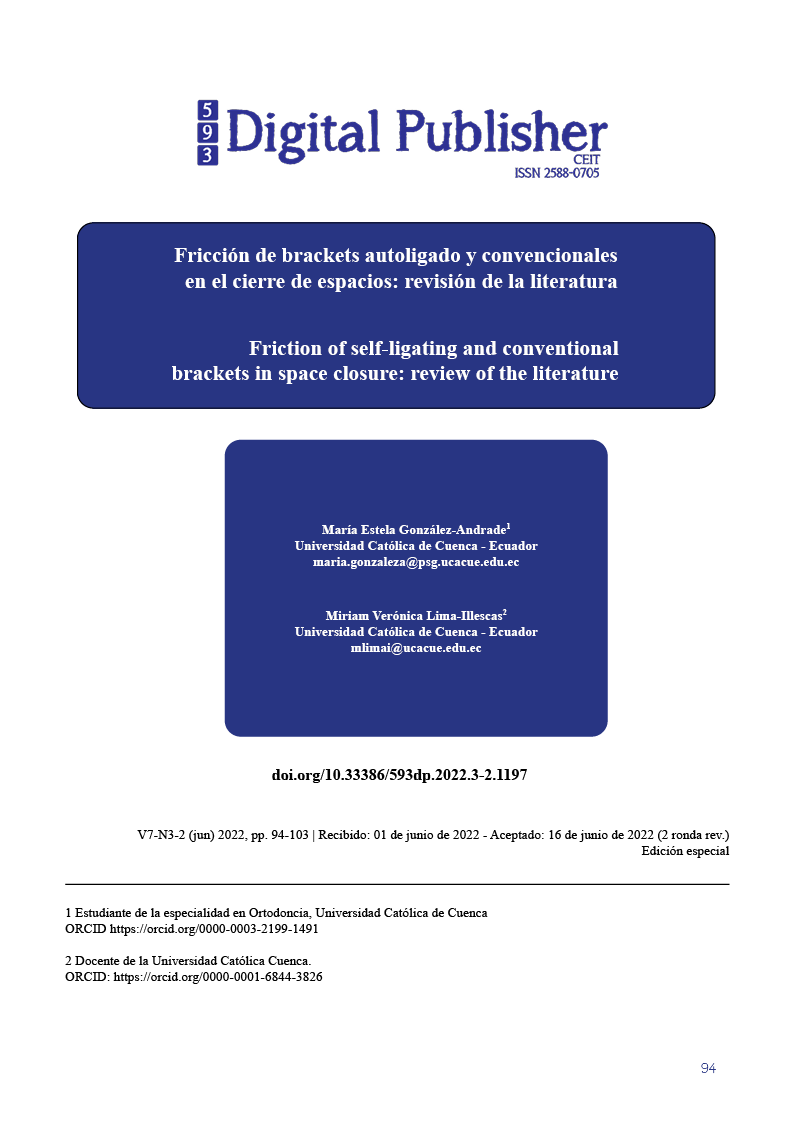Fricción de brackets autoligado y convencionales en el cierre de espacios: revisión de la literatura
Contenido principal del artículo
Resumen
La fricción en ortodoncia se debe al contacto entre el arco, método de ligadura y el bracket, la fricción reduce la fuerza aplicada para los movimientos dentales por lo que es necesario aplicar mayor fuerza para producir el movimiento dental, en relación al método de ligadura empleada para el deslizamiento existen diferentes mecánicas para el cierre de espacios, una de ellas es mediante la confección de ansas para producir cierre de espacios con mínima fricción conocida como mecánica no deslizante y la mecánica deslizante en la cual los brackets se deslizan a través del arco mediante el uso de resortes o cadenetas generando mayor fricción, es por ello que se introducen los brackets de autoligado, por presentar mejores ventajas en comparación con los brackets convencionales, con menor fricción, menor tiempo de trabajo, eficacia de alineación entre otros. Objetivo: Analizar la literatura actual sobre la fricción de brackets autoligado y brackets convencionales en el cierre de espacios. Metodología: Se realizó una búsqueda en las bases de datos PubMed, Scopus, Web of Science y BVS regional, después de aplicar los criterios de inclusión y exclusión se obtuvo 26 estudios que cumplieron con los parámetros establecidos para la presente revisión. Conclusión: No existe diferencia en cuanto a la fricción de brackets de autoligado en comparación con los brackets convencionales en el cierre de espacios, sin embargo, existen otras variables que muestran diferencias entre brackets de autoligado y brackets convencionales en relación al tiempo de tratamiento y la pérdida de anclaje.
Descargas
Detalles del artículo

Esta obra está bajo una licencia internacional Creative Commons Atribución-NoComercial-CompartirIgual 4.0.
1. Derechos de autor
Las obras que se publican en 593 Digital Publisher CEIT están sujetas a los siguientes términos:
1.1. 593 Digital Publisher CEIT, conserva los derechos patrimoniales (copyright) de las obras publicadas, favorece y permite la reutilización de las mismas bajo la licencia Licencia Creative Commons 4.0 de Reconocimiento-NoComercial-CompartirIgual 4.0, por lo cual se pueden copiar, usar, difundir, transmitir y exponer públicamente, siempre que:
1.1.a. Se cite la autoría y fuente original de su publicación (revista, editorial, URL).
1.1.b. No se usen para fines comerciales u onerosos.
1.1.c. Se mencione la existencia y especificaciones de esta licencia de uso.
Citas
A. Hempel G. Sat, M. V. V. D. (2021). Comparación de Brackets de Autoligado y Brackets Convencionales basada en la evidencia. Odontoestomatología, 38, 1–14. https://doi.org/10.22592/ode2021n37e302
Abu-Shahba, R., & Alassiry, A. (2019). Comparative evaluation of the maxillary canine retraction rate and anchorage loss between two types of self-ligating brackets using sliding mechanics. Journal of Orthodontic Science, 8, 3. https://doi.org/10.4103/jos.JOS_73_18
Ahmed, N., Megalan, P., Suryavanshi, S., Sidiqha, N., & Kumar, K. (2019). Effect of Bracket Slot and Archwire Dimension on Posterior Tooth Movement in Sliding Mechanics : A Three-dimensional Finite Element Analysis. Cureus, 11(9). https://doi.org/10.7759/cureus.5756
Alsabti, N., & Talic, N. (2021). Comparison of static friction and surface topography of low friction and conventional TMA orthodontic arch wires : An in-vitro study. The Saudi Dental Journal, 33(5), 268–275. https://doi.org/10.1016/j.sdentj.2020.03.006
Barbosa, W. C. S., Correr, A. B., Carneiro, D. P. A., Vedovello Filho, M., Godoi, A. P. T. de, & Valdrighi, H. C. (2019). Evaluation of friction on self-ligating and conventional brackets associated with different types of archwires submitted to sliding mechanics. Brazilian Journal of Oral Sciences, 18(SE-Article), e191605. https://doi.org/10.20396/bjos.v18i0.8657258
Barsoum, H. A., ElSayed, H. S., Sharaby, F. A. El, Palomo, J. M., & Mostafa, Y. A. (2021). Comprehensive comparison of canine retraction using NiTi closed coil springs vs elastomeric chains: A split-mouth randomized controlled trial. Angle Orthodontist, 91(4), 441–448. https://doi.org/10.2319/110620-916.1
Carvalho, F. Costa, A. Carvalho, S. et al. (2019). Lubricating conditions : effects on friction between orthodontic brackets and archwires with different cross-sections. Dental Press J Orthod, 24(2), 66–72.
Dehbi, H., Azaroual, M. F., Zaoui, F., Halimi, A., & Benyahia, H. (2017). Therapeutic efficacy of self-ligating brackets: A systematic review. International Orthodontics, 15(3), 297–311. https://doi.org/10.1016/j.ortho.2017.06.009
do Nascimento, L.-E.-A.-G., Pithon, M.-M., Ruellas, A.-C. de O., Franzotti, E.-S. A., Filho, A.-C.-G., de Souza, M.-M.-G., & Bolognese, A.-M. (2020). Rates of tooth movement and bone remodeling activity: Self-ligating versus conventional brackets. Journal of Clinical and Experimental Dentistry, 12(4), e391–e398. https://doi.org/10.4317/jced.56615
Gómez, S. L., Montoya, Y., Garcia, N. L., Virgen, A. L., & Botero, J. E. (2016). Comparison of frictional resistance among conventional, active and passive selfligating brackets with different combinations of arch wires: a finite elements study. Acta Odontologica Latinoamericana : AOL, 29(2), 130–136. http://www.scielo.org.ar/pdf/aol/v29n2/v29n2a05.pdf
Gomez, S. L., Sanchez-Obando, N., Alvarez-Castrillon, M. A., Montoya-Goez, Y., & Ardila, C. M. (2019). Comparison of frictional forces during the closure of extraction spaces in passive self-ligating brackets and conventionally ligated brackets using the finite element method. Journal of Clinical and Experimental Dentistry, 11(5), e439–e446. https://doi.org/10.4317/jced.55739
Kawamura, J., & Tamaya, N. (2019). A finite element analysis of the effects of archwire size on orthodontic tooth movement in extraction space closure with miniscrew sliding mechanics. Progress in Orthodontics, 20(1). https://doi.org/10.1186/s40510-018-0255-8
L. Pigato P. Beom, K. da C. M. A. S. A. G. (2019). Which one closes extraction spaces faster : en masse retraction or two-step retraction ? A randomized prospective clinical trial. An International Journal of Orthodontics and Dentofacial Orthopedics since 1930, 89(6). https://doi.org/10.2319/101618-748.1
Mittal, R., Attri, S., Batra, P., Sonar, S., Sharma, K., & Raghavan, S. (2020). Comparison of orthodontic space closure using micro-osteoperforation and passive self-ligating appliances or conventional fixed appliances: A randomized controlled trial. Angle Orthodontist, 90(5), 634–639. https://doi.org/10.2319/111119-712.1
Mohammed, Hisham, Rizk, M., Wafaie, K., & Almuzian, M. (2017). Effectiveness of nickel-titanium springs vs elastomeric chains in orthodontic space closure: A systematic review and meta-analysis. Orthodontics & Craniofacial Research, 21. https://doi.org/10.1111/ocr.12210
Monini, A. da C., Gandini, L. G., Vianna, A. P., Martins, R. P., & Jacob, H. B. (2019). Tooth movement rate and anchorage lost during canine retraction: A maxillary and mandibular comparison. The Angle Orthodontist, 89(4), 559–565. https://doi.org/10.2319/061318-443.1
Moyano, J., Mases, L., Izeta, T., Flores, T., Fernández-Bozal, J., Gil, J., & Puigdollers, A. (2019). “In Vitro” Study About Variables that Influence in Arch Friction with Conventional and Self-Ligating Brackets. In Materials (Vol. 12, Issue 20). https://doi.org/10.3390/ma12203279
Qamruddin, I., Gul, A., Asif, F., Karim, M., Nowrin, S., Shahid, F., & Alam, M. (2020). Pain Perception and Rate of Canine Retraction Through Self-Ligating Brackets and Conventional Elastomeric Ligation System: A Split Mouth Study. Pesquisa Brasileira Em Odontopediatria e Clínica Integrada, 20. https://doi.org/10.1590/pboci.2020.034
Ribeiro, G. L. U., & Jacob, H. B. (2016). Understanding the basis of space closure in Orthodontics for a more efficient orthodontic treatment. Dental Press Journal of Orthodontics, 21(2), 115–125. https://doi.org/10.1590/2177-6709.21.2.115-125.sar
Rizk, M. Z., Mohammed, H., Ismael, O., & Bearn, D. R. (2017). Effectiveness of en masse versus two-step retraction : a systematic review and meta-analysis. Progress in Orthodontics, 1–11. https://doi.org/10.1186/s40510-017-0196-7
Sanjay, N., Rajesh, R. N. G., Scindia, R., & Ajith, S. D. (2015). Space closure with loop mechanics for treatment of bimaxillary protrusion: a case report. Journal of International Oral Health : JIOH, 7(5), 65–67. http://www.ncbi.nlm.nih.gov/pubmed/26028908%0Ahttp://www.pubmedcentral.nih.gov/articlerender.fcgi?artid=PMC4441242
Schneider, P. P., Kim, K. B., da Costa Monini, A., Dos Santos-Pinto, A., & Gandini, L. G. J. (2019). Which one closes extraction spaces faster: en masse retraction or two-step retraction? A randomized prospective clinical trial. The Angle Orthodontist, 89(6), 855–861. https://doi.org/10.2319/101618-748.1
Suryavanshi, S., Lingareddy, U., Ahmed, N., Neelakantappa, K. K., Sidiqha, N., & Minz, M. (2019). In Vitro Comparative Evaluation of Frictional Resistance of Connecticut New Arch Wires, Stainless Steel and Titanium Molybdenum Alloy Archwires Against Different Brackets. Cureus, 11(11). https://doi.org/10.7759/cureus.6131
Tarmizi, I., Siregar, E., & Soegiharto, B. M. (2017). A comparison of the rate of en-masse space closure using conventional and passive self-ligating brackets with closed-coil springs. Journal of Physics: Conference Series, 884, 12097. https://doi.org/10.1088/1742-6596/884/1/012097
Vieira, E. P., Watanabe, B. S. D., Pontes, L. F., Mattos, J. N. F., Maia, L. C., & Normando, D. (2018). The effect of bracket slot size on the effectiveness of orthodontic treatment: A systematic review. Angle Orthodontist, 88(1), 100–106. https://doi.org/10.2319/031217-185.1
Yang, X., Xue, C., He, Y., Zhao, M., Luo, M., Wang, P., & Bai, D. (2018). Transversal changes, space closure, and efficiency of conventional and self-ligating appliances : A quantitative systematic review. Journal of Orofacial Orthopedics = Fortschritte Der Kieferorthopadie : Organ/Official Journal Deutsche Gesellschaft Fur Kieferorthopadie, 79(1), 1–10. https://doi.org/10.1007/s00056-017-0110-4



